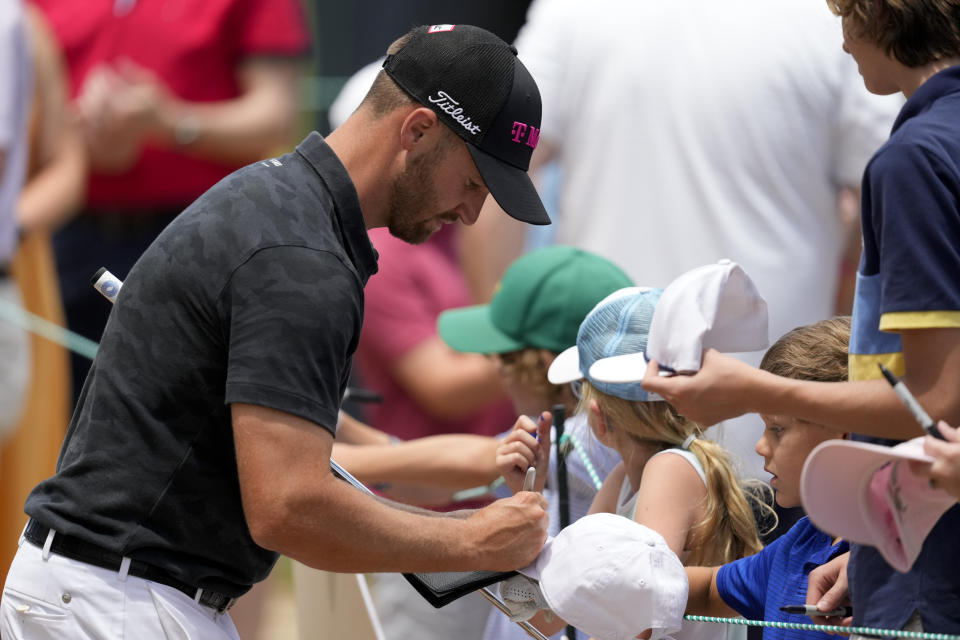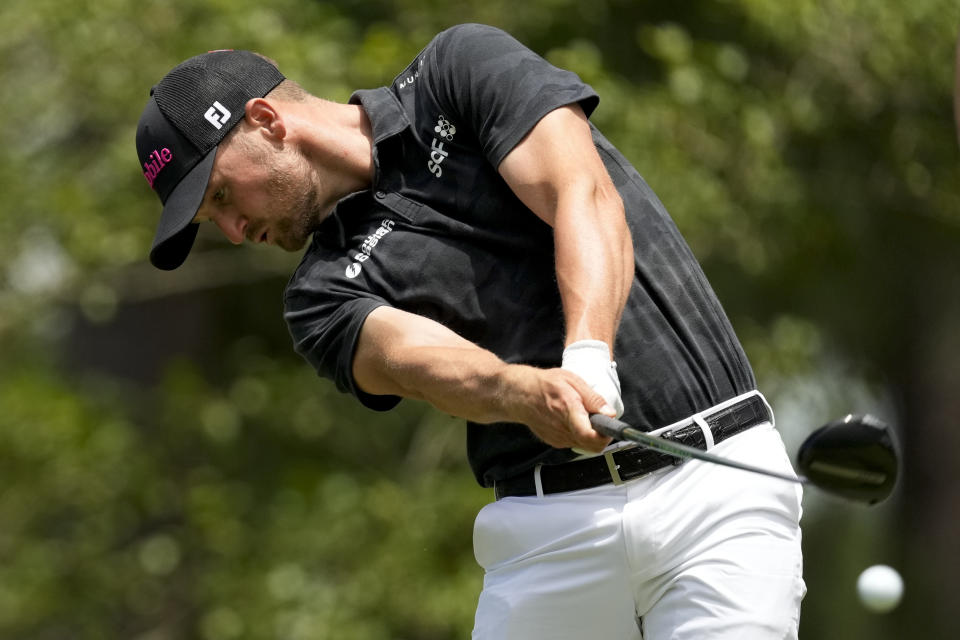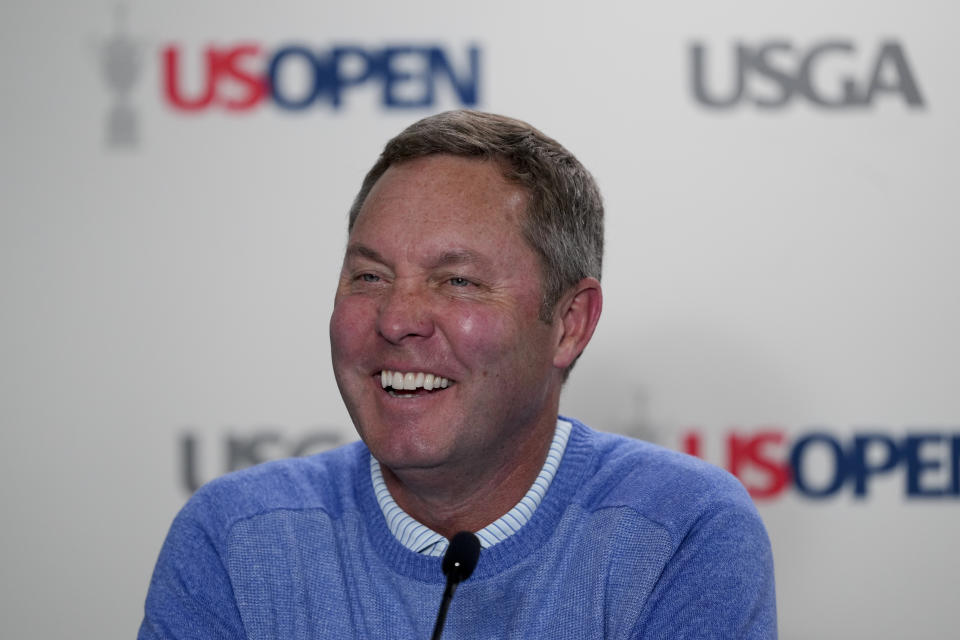Wyndham Clark trying to regain his form as he begins his U.S. Open title defense at Pinehurst No. 2
PINEHURST, N.C. (AP) — Wyndham Clark walked off the second tee during his practice round at the U.S. Open on Wednesday, the sun just beginning to rise over Pinehurst No. 2, and slowly went down the rope line signing flag after flag for eager kids.
Most called him “Mr. Clark.” A couple simply called him “Wyndham,” as if they had known him forever.
It was hard to believe the golf world was just getting to know him a year ago.
Yes, most who follow the PGA Tour knew that Clark had been grinding away for years, and come close to winning, before his breakthrough at the Wells Fargo a couple hours away at Quail Hollow in Charlotte. But it wasn't until his one-shot victory over Rory McIlroy in the U.S. Open at Los Angeles Country Club that casual fans began taking notice of him.
Clark won again at rainy Pebble Beach in February, but the run-up to his U.S. Open title defense has been tough. He played four rounds over par in his return to Quail Hollow before missing the cut at the PGA Championship and the Memorial.
“I have to work on my expectations, just not putting so much pressure on myself,” he said. “It is tough. I mean, it’s obviously challenging being one of the top players, especially doing it as quickly as I did. There’s ebbs and flows in the game of golf.”
Clark marveled at the way Scottie Scheffler has managed them, then pointed out that it isn't so easy for everyone else.
“There’s a lot of other guys that struggle a lot of the weeks of the year and play good maybe just a few events,” Clark said. “I mean, I’ve been kind of bummed as of late with my game. I’m always reminded when I get on these practice tees and hit good shots, I’m still doing a lot of good things in practice, makes me feel like I’m not far.”
The alternate
Josh Radcliff spent the last of his three days at Pinehurst No. 2 playing with Jordan Spieth and Sam Burns. Wednesday was the final tune-up for the U.S. Open.
At least for Spieth and Burns.
Radcliff is virtually certain to be headed home on Thursday. He was the first alternate out of the Dallas qualifier, which he said was No. 8 on the list of alternates if an exempt player were to withdraw. His only other hope was for a qualifier from Dallas to pull out.
Disappointed? Far from it.
Radcliff, who has never made it past PGA Tour Americas, took advantage of being able to play a U.S. Open course at Pinehurst No. 3, practice alongside the top players in the world, eat lunch in player dining and enjoy all the perks but two — no courtesy car and no tee time.
And he saw another value.
“The next time I’m at a major or my first PGA Tour event, I’ll at least have the experience of being there,” he said. “No tour trucks, no star gazing.”
Playing with Spieth wasn’t about star gazing. They were at Jesuit Dallas Prep School together, when Spieth was a senior and Radcliff a freshman. Radcliff asked him for a practice round. Spieth was all too happy to oblige once he figured out what Radcliff was doing at Pinehurst.
That in itself was a measure of determination.
The Dallas qualifier offered 11 spots and ended with a 7-for-6 playoff for the last spot. Sergio Garcia got eliminated and was the first alternate. Radcliff, who finished one shot out of the playoff, then had to compete in a 6-man playoff for the right to be second alternate.
He birdied the first hole. And then Garcia was added to the field as an alternate, moving Radcliff up to first alternate out of Dallas (No. 8 alternate overall).
The USGA changed its policy on first alternates in 2017 that gives them full privileges of the course and practice areas (with some time restrictions). Previously, alternates could not use the practice facilities or play on the golf course.
‘A head start’
USGA chief executive Mike Whan believes a college course-turned-apprenticeship program piloted at Sandhills Community College last year will help the golf industry combat a shortage of skilled labor at courses around the country.
Whan said Wednesday the USGA and its partners were committing $1 million to help fund the Greenskeeper Apprenticeship Program until 2029, when the U.S. Open returns to Pinehurst No. 2. The program, which marries classroom instruction with on-course training, also will expand to Horry-Georgetown College in neighboring South Carolina.
“We thought it was going to be a fun project for a year,” Whan said. “What came out of a fun project was a program, ‘If you take this class here in Sandhills, you had a job.' You were working on a golf course. If you didn’t have one when you started, we got (you) one when you started. You didn’t pay for this course.”
Whan said every graduate of the first class had a salary increase where they were working. Half had received promotions.
“There’s a deep and diverse pool of talent here," Whan said, “and we just had to give them a head start.”
US Open money
The U.S. Open is likely to end the year as having the richest purse among the four majors. Whan, the CEO of the USGA, said Wednesday the prize fund would be $21.5 million. The USGA already has said it is changing its formula so that 20% of the purse goes to the winner.
That translates to $4.3 million — more than the entire purse for the U.S. Open in 1999 when it first came to Pinehurst No. 2.
LIV and the US Open
Whan said the USGA was still looking into a path for LIV Golf players to get exempt for the U.S. Open. He just isn't sure what that would look like because he doesn't know the direction of LIV or any reconciliation with the PGA Tour.
“I think we are serious about that. Exactly what that looks like and how that’ll curtail ... I’m not just being coy, we haven’t done that yet,” he said Wednesday.
The U.S. Open is the most democratic of all majors, with 46% of the field having to go through 36-hole qualifying this year.
Seven of the top 10 on LIV's points list this year got into the U.S. Open. Five of the top 10 in LIV points from last year got in. Some had to go through qualifying.
“If I’m being perfectly honest with you, we’ve always felt like for the last year-and-a-half that we’re always three months away from understanding what the new structure is going to look like,” he said of LIV Golf.
“I think it’s feasible. I don’t think it’s a huge pathway, but we do offer other pathways,” he said citing the European tour and Korn Ferry Tour. “So we know that there’s an option to get there.”
___
AP Golf Writer Doug Ferguson contributed.
___
AP golf: https://apnews.com/hub/golf






